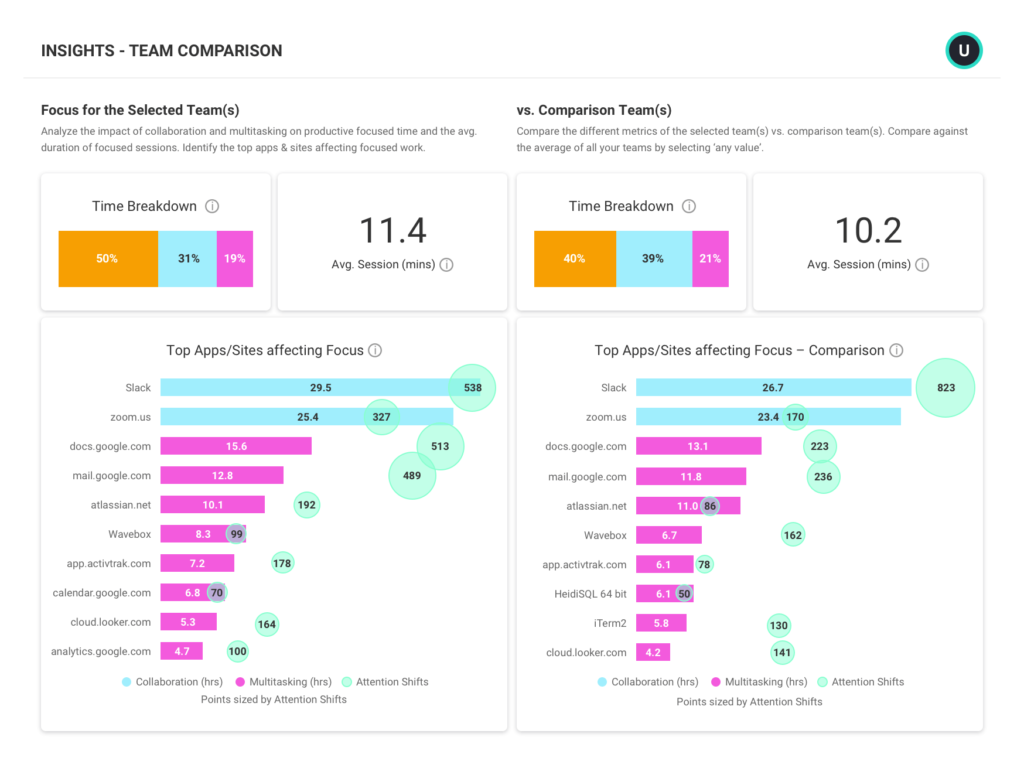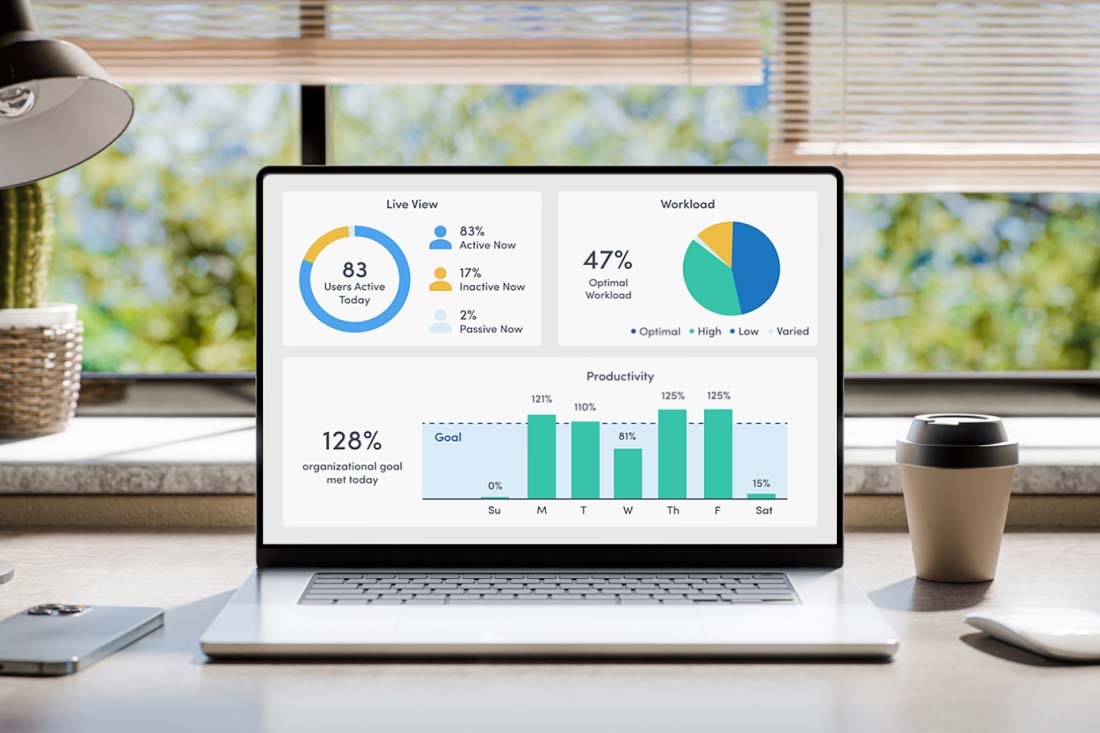Workforce planning is an essential pillar of organizational success, ensuring that you have the right people in the right roles at the right time to achieve strategic objectives. Key tools in workforce planning are analytics and metrics.
In this post, we’ll explore workforce planning metrics and benefits, including strategies to overcome implementation challenges.
What Are Workforce Planning Metrics?
Workforce planning metrics are quantitative data points that help organizations better understand and manage their employees. These metrics include employee turnover rates, time-to-hire, vacancies, training and development investments, employee engagement and satisfaction, capacity levels, technology usage, and productivity. Tracking and analyzing these key metrics allows leaders to be more informed about things like headcount planning, technology investments and optimization opportunities related to workforce investments.
22 Workforce Planning Metrics Your Business Should Measure
While numerous metrics contribute to efficient and effective workforce planning, it’s important to prioritize those that align with your company’s goals and culture. Collaborating with stakeholders across your organization can help you determine which workforce planning metrics matter the most and have the greatest impact on your decision-making.
If you aren’t sure where to start, here are 22 workforce planning metrics we think are important for 2024:
1. Headcount
Headcount is the total number of employees you have. This may sound like a simple metric, but it’s often a shifting number, especially if you have part-time or contract workers. Monitoring headcount changes over time can help you determine the health of your workforce management and plan for future changes, such as seasonal hiring or departmental expansions. It is also an important function of headcount planning to help you identify unused capacity and inform staffing decisions.
Headcount Planning is now an integral component of ActivTrak’s Workforce Planning solution that helps leaders optimize the value of workforce investments.
2. Employee Engagement
Employee engagement measures an employee’s commitment to their work and achieving company goals. It can be a difficult metric to measure because it deals with employee sentiment, such as how they feel about their team, their work and the organization overall, as well as how those feelings manifest in their actions. There are numerous ways to measure employee engagement, usually through self-reporting such as surveys, one-on-one meetings with managers or internal productivity metrics.
Activtrak makes it easy to measure engagement and spot disengagement.

3. Employee Productivity
Employee productivity measures how much employees get done (outputs) against the resources they invest to do so (inputs). It is calculated by dividing total outputs such as completed units, sales or objectives achieved, by inputs such as cumulative hours spent. Each organization measures productivity differently based on its outputs and inputs, which makes calculating and standardizing productivity difficult.
ActivTrak provides employee productivity monitoring software that collects and analyzes digital data points to measure productivity more objectively.
4. Employee Capacity
Employee capacity compares the number of hours you expect employees to be productive to the amount of time they’re actually productive. Most organizations have a gap in this area, which can be caused by a number of factors. For example: Top performers who consistently work overtime may not delegate enough responsibilities to their underutilized peers, or employees may be unclear about expectations after a reorganization or change in leadership.
Effectively analyzing employee capacity requires observing day-to-day productivity trends. This lets you see if employees have enough focus time for problem-solving and creative thinking, or if they need help minimizing distractions and improving work efficiency.
5. Employee Utilization
Employee utilization measures how efficient your organization is at distributing work across teams. Monitoring this metric helps you understand if employees are at risk of burnout (overutilized and overworked), or if anyone’s skills are being wasted due to underutilization. Regularly evaluating this metric helps managers ensure no one’s carrying too much or too little of the workload.
Common formulas for calculating employee utilization involve dividing billable hours by actual hours worked, but these only tell part of the story. A more reliable method is workload management software that reveals dips and spikes in hours worked, revealing early signs of burnout and disengagement so you can take steps to correct them.
6. Burnout Rate
Employee burnout is a measure of exhaustion caused by work-related stress. It’s a difficult metric to nail down without clear definition or medical diagnosis. Three dimensions of burnout can affect organizational productivity and morale: exhaustion, feeling negative about your job and a reduced ability to complete professional tasks.
To measure employee burnout, you can use surveys such as the Maslach Burnout Inventory to score employees on the three dimensions. However, employees must feel secure in answering the questions and anonymous surveys may yield more candid results.
We prefer using an application like ActivTrak, which takes a data-driven approach to identify early signs of burnout. This allows managers to proactively address it with employees and incorporate it in their headcount planning initiatives.
7. Absenteeism Rate
Absenteeism, whether due to personal or workplace factors, is expensive for employers and can signal underlying issues — such as workplace harassment, employees who are job hunting or working multiple jobs simultaneously. Monitoring absenteeism rates provides visibility into potential challenges and empowers proactive measures to address them before they escalate.
To calculate absenteeism, divide the total number of days missed by all employees by the number of workdays available, and multiply by 100.
Example: 17 days missed/63 workdays in the quarter = 0.27 x 100 = 27% rate of absenteeism this quarter.
8. Retention Rate
Employee retention is a key HR metric that measures an organization’s ability to retain talent and reduce or prevent employee turnover. It can also measure employee satisfaction and engagement levels. Many candidates will look for high retention rates at a company to gauge how likely they are to enjoy working there.
To calculate your retention rate, divide the total number of employees who stayed at your company over a given period by the headcount you had on day one, and multiply by 100.
Example: 195 employees stayed the year/200 employees on Jan 1 = 0.975 = 97.5% employee retention rate for the year.
9. Attrition Rate
Unlike your employee turnover rate, which measures when an employee leaves and is immediately replaced, your attrition rate reveals permanent losses due to positions that have been eliminated or take a long time to refill. High attrition is a sign for HR to dig deeper into other important metrics, such as employee engagement, burnout, absenteeism and productivity.
To calculate your attrition rate, divide the number of employees who left your company during a specific period by the average number of employees at the same time, and multiply by 100.
10. Turnover Rate
Employee turnover is a measure of how often employees leave your company within a specific time frame and can be a big indicator of employee satisfaction, engagement and workplace culture vitality. High turnover rates may also signal issues with your recruitment processes.
To calculate your turnover rate, divide the number of people who have left your workforce by the average number of employees in that period, and multiply by 100.
Example: 5 employees left/200 employees average = 0.025 x 100 = 2.5% turnover rate.
Excluding employees who left due to reasons like retirement can provide a clearer picture of your actual turnover rate and support more strategic headcount planning.
11. Tenure Rate
An employee’s tenure rate represents how long they’ve been with a company. Like retention and turnover rates, it can be an important workforce planning metric for providing insights into workforce health, stability and succession planning. Monitoring tenure rates aids in identifying long-term workforce trends and planning for future talent needs.
To calculate employee tenure, subtract each employee’s start date from the current date, or the date they leave the company, then add those numbers together and divide by the number of employees to get the average.
Example:
Employee 1: Worked at the company 3,000 days
Employee 2: Worked at the company 4,380 days
Employee 3: Worked at the company 650 days
3000 + 4380 + 650 = 8,030 days/3 employees = 2,676.67 days average tenure
This average can be skewed if you have many new employees leaving while older employees stay on longer. Knowing your retention and turnover rates can provide a more complete picture.
12. Internal Mobility Rate
In HR, internal mobility denotes the progression of employees to different roles, opportunities or positions within your organization. This encompasses not only upward advancement like promotions but also demotions, newly created positions, lateral moves and other changes. Tracking internal mobility rates supports talent retention and fosters a culture of growth and development.
To calculate internal mobility, divide the total number of job movements in your organization by the average number of employees over that same period, and multiply by 100.
Example: 4 job changes/200 employees = 0.02 x 100 = 2% internal mobility
13. Cost per Hire
Cost per hire is a vital recruiting metric that measures the average expenditure incurred in acquiring new talent. That encompasses advertising expenses, labor costs for recruiting teams and other costs related to hiring new candidates. Utilizing this metric aids in directing budget allocation and refining recruitment strategies.
To calculate cost per hire, add up all recruiting expenses (both internal and external) and divide by the total number of hires over a given range of time.
14. Quality of Hire
Assessing the quality of a new hire is challenging because it sums up the value they bring to your company. Companies often measure the quality of a hire by how much an employee has contributed to organizational success. This can take time to accurately assess. Each HR department may have its own ways of doing so, including performance and productivity, as well as how an employee interacts with coworkers through turnover or retention. Getting the quality of a hire right is a critical component of successful headcount planning.
15. Failed Hire Rate
The failed hire rate measures how many new hires leave an organization in a given period, usually a certain number of months after they’re hired. As with other turnover metrics, it can be a valuable tool in understanding the health of your hiring and onboarding processes.
To calculate your failed hire rate, divide the number of new employees who have left by the number of all of the employees who were newly hired in the same period.
16. Average Training Time
Onboarding new employees involves training them, and understanding the time it takes an average employee to learn their new role can be an important metric for your team.
To calculate average training time, divide the total number of training hours by the number of employees in training over that period.
Using a workforce analytics solution makes it easy to track training program efficiency by establishing ideal onboarding training times and tracking employee progress against their respective goals.
17. Training Cost per Employee
Understanding how much your organization spends on training can help you evaluate the return on investment of your employee development initiatives. One report by the Association for Talent Development reported that on average, a company will spend $1,252 per employee on training and development.
To calculate training cost per employee, divide the total amount of money spent on training by the number of employees who were trained.
18. Diversity and Inclusion
Diversity and inclusion have become increasingly vital for organizational growth. While some may interpret this heightened focus as superficial, having a workforce with a variety of backgrounds can improve competitive advantage — including more creativity, a broader range of skill sets, increased productivity, more satisfied employees and even higher revenues.
To calculate your diversity and inclusion percentage, divide the total number of employees from a specific group (e.g., women or Black employees) by the total number of employees in the organization, and multiply by 100.
Example: 85 women/200 employees = 0.425 x 100 = 42.5%of employees are women.
19. Workspace Utilization
Workspace utilization indicates the efficiency of your physical office spaces. This metric is critical in the era of hybrid work. It looks at how many employees use your office space — and how often — to uncover excess capacity and reveal opportunities for right-sizing your office real estate.
To calculate workspace utilization, divide the total number of employees by your total workplace capacity. For example, if you have 250 employees in a space designed for 500, your utilization is 50%.
For greater accuracy, use location insights to see where employees work and where they’re most productive. These insights are more accurate than traditional badge data and remove the guesswork from office real estate decisions.
20. Technology Utilization
Technology utilization shows how efficiently your organization uses software. Most companies overpay for unused software licenses and underutilized apps. This metric shows how often your tools are used, who’s using them and how they impact productivity. Organizations that measure software utilization are better positioned to maximize SaaS spend and increase ROI.
The most accurate way to monitor technology utilization is by using workforce analytics to validate usage rates. A solution like ActivTrak can show you when teams don’t use apps as expected so you can reallocate your budget or invest in training.
21. Job Satisfaction
Knowing how your employees feel about their jobs can help you determine what may be missing from your workplace. Because job satisfaction is a subjective measurement, it is best assessed through employee surveys. However, cross-referencing job satisfaction rates with other metrics such as employee productivity, retention and turnover, can provide valuable insights into areas for enhancement.
22. eNPS Score
The employee Net Promoter Score (eNPS) measures how likely your employees are to recommend your company to others. It’s a way to assess employee engagement and job satisfaction by offering insights into organizational culture. An organization’s eNPS is determined by an anonymous one-question survey that asks, “On a scale of 0-10, how likely are you to recommend this company’s products and services to others?” Employees who answer 9-10 are considered promoters, while those answering with a six or below are considered detractors. Other respondents are considered passive. Higher scores indicate a more engaged workforce.
Track Workforce Planning Metrics with ActivTrak
When it comes to human resource management, workforce planning metrics play a big role in your organization’s ability to plan for your company’s success. ActivTrak can provide data and metrics on employee engagement, productivity and satisfaction through our employee monitoring platform. Contact our sales team to learn more about how our workforce planning solutions can help you track the metrics that matter for your organization.





